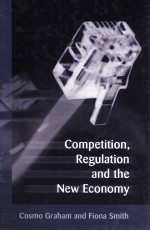

COMPETITION REGULATION AND THE NEW ECONOMYPDF电子书下载
- 电子书积分:10 积分如何计算积分?
- 作 者:COSMO GRAHAM AND FIONA SMITH
- 出 版 社:OXFORD AND PORTLAND OREGON
- 出版年份:2004
- ISBN:1841133841
- 页数:206 页
1. Introduction&COSMO GRAHAM 1
1. The New Economy and its Characteristics 2
2. Potential Problems for Competition Policy 4
A. Predation 6
B. Tying and Bundling 7
C. Intellectual Property Rights 8
D. Collective Conduct 8
E. Mergers 9
3. Conclusions on Competition Policy 9
4. Regulatory Questions 10
5. Subsequent Chapters 12
2. Article 82 EC and New Economy Markets&GIORGIO MONTI 17
1. Competing Perspectives of New Economy Markets 18
A. Neo-structuralism 18
B. Neo-Schumpeterianism 22
C. The Response of the Authorities 24
2. Relevant Market Analysis 24
A. On-Line Music 25
B. Top-Level Internet Service Providers 28
C. Structuralism Prevails 31
3. Dominance 31
A. The Traditional Test: Market Shares Plus Entry Barriers 32
B. Neo-Schumpeterian Definitions of Dominance 33
4. Abuse 36
A. Protecting One’s Dominant Position 36
B. Obligations to Co-operate with Competitors 41
C. Extending Dominance 45
5. An Innovation Defence? 47
6. Remedies 50
7. Conclusion 53
3. Abuse of a Dominant Position and Intellectual Property Rights: A Suggestion to Reconcile the Community Courts’ Case Law&ESTELLE DERCLAYE 55
1. Confusion in the Case Law 56
A. The Factual Background of the Case 57
B. Conditions Required to Establish the Abuse 59
2. An Illustration of the Confusion: The IMS Case 61
A. The Factual Background of the Case 61
B. The Decision of the Commission 62
C. The Orders of the President of the Court of First Instance 64
D. Comments 64
3. How to Solve the Dilemma: A Suggestion 65
A. Argument 66
B. A Few Other Corroborating Arguments 73
4. Conclusion 74
4. B2B E-Marketplaces: A New Challenge to Existing Competition Law Rules?&JOACHIM LUCKING 77
1. B2B E-Marketplaces: Technical and Commercial Developments 77
2. Regulatory Responses 79
3. The Legal Assessment of B2B E-Marketplaces under EC Competition Law 80
A. Legal Basis 80
B. Market Definition 81
C. Competition Issues 83
D. Co-ordination Effects 83
E. Market Dominance and Foreclosure 86
4. Best Practice Guidelines 89
5. Conclusion 90
5. Authorities, Competition and Electronic Communication: Towards Institutional Competition in the Information Society&PLG NIHOUL 91
1. National Systems Replaced by a European Organisation 92
A. First Stage of the Reform 92
B. The 1987 Green Paper 93
C. What Legal Basis? 94
D. An Institutional Provision 95
E. Modification of the Rapport de Forces 96
F. Legislative Power 97
2. The Debate Between Harmonisation and Liberalisation 99
A. Second Stage of the Reform 99
B. Rules Adopted by the Commission 99
C. New Interpretation of Competition Law 100
D. Harmonisation Process 101
E. Harmonisation Directives 101
D. Two Categories of Rules 103
G. Contradictions 104
3. Conflict at National Level 106
A. Third Stage of the Reform 106
B. National Regulatory Authorities (NRAs) 107
C. National Competition Authorities (NCAs) 108
D. National Courts 109
4. Convergence from an Institutional Point of View 109
A. Fourth Stage of Development 109
B. Illustration 110
5. An Institutional Interpretation of the Reform 111
A. Conflict and Competition Among Authorities 111
B. The Process of Regulatory Competition 112
C. Institutional Competition in Electronic Communications 114
D. Competition Among Authorities Within the Same Legal Order 115
E. Expanding the Line of Business 116
6. What Can We Learn About the Future? 119
A. More Competition among Authorities 119
B. First Difficulty: Regulation Not an Ordinary Good 120
C. Solution: Competition Within a Given Framework 120
D. Second Difficulty: Legal Certainty and Predictability 121
E. Place of Unity in Society and the Legal System 122
F. Conformity with an Information and Communication Based Society? 123
6. Controlling the New Media:Hybrid Responses to New Forms of Power&ANDREW MURRAY AND COLIN SCOTT 126
1. New Media and the Problems of Effective Control 128
A. The Regulatory Arbitrage Problem 128
B. The Anonymity Problem 130
C. The Scarce Resources Problem 132
2. Extending the ‘Modalities of Regulation’ Analysis 136
3. Putting Controls to Work 143
A. Hierarchy/Community 143
B. Hierarchy/Competition 146
C. Hierarchy, Competition and Design 150
D. Other Forms of Control 152
E. Excluding Hierarchy 156
4. Conclusion 156
7. Regulating E-Commerce in the WTO:Exploring the Classification Issue&FIONA SMITH 159
1. Background 162
2. Defining E-Commerce 167
3. Applying GATT and GATS to E-Commerce: Is E-Commerce Trade in Goods or Services? 172
A. GATT 173
B. GATS 175
4. Conclusion 183
8. Public Services in the New Economy&ERIKA SZYSZCZAK 185
1. The Provision of Public Services 185
2. The Political Economy of State Intervention 187
3. Challenges to the Provision of Public Services 189
4. The Challenge to State Autonomy 191
5. Hybridisation 194
6. The Provision of Public Services by Non-State Actors 199
A. Economic Regulation 202
B. Market Power and Special Responsibility 203
7. Conclusion 205
